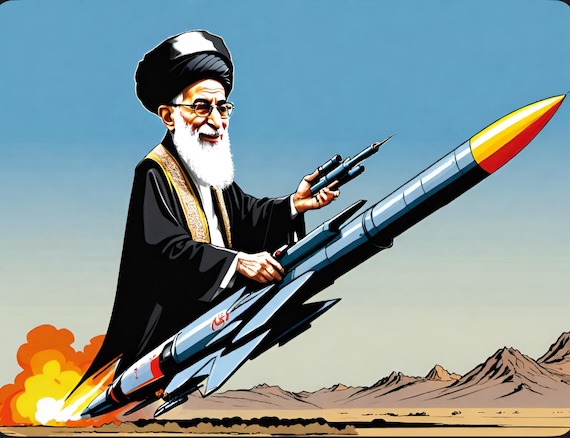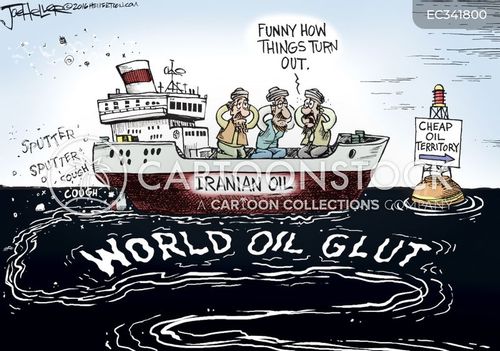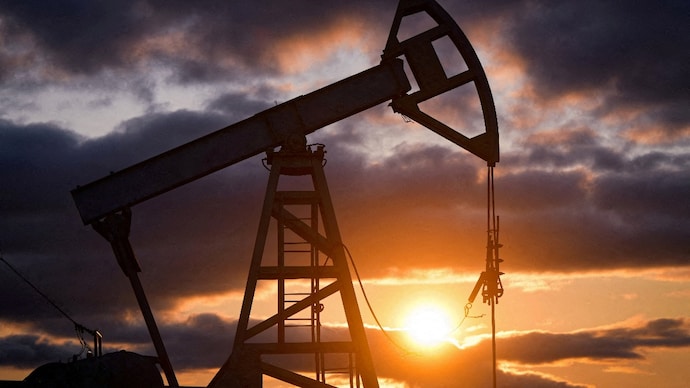Middle East Ignites, Oil Boils, Haifa Hit, Hormuz At Risk; The Oil War We Were All Dreading Has Begun! Will The World Economy Burn Next?

Crude oil prices extended their rally on Sunday, adding to last week’s 7% surge, as tensions between Israel and Iran intensified, raising fresh concerns over global energy security.
U.S. crude rose 1.2% to $73.85 per barrel, while Brent, the global benchmark, gained 1% to hit $75. Earlier in the day, both had traded even higher, indicating market nervousness.
However, the situation took a dramatic turn on Monday morning local time, when explosions rocked the Israeli port city of Haifa. Strikes reportedly hit areas near an oil refinery, setting buildings ablaze. Israel claims the attacks were part of a new wave of missile launches by Iran.
Markets are now bracing for potential disruptions to energy exports from the region – especially through the Strait of Hormuz, a critical oil transit chokepoint that handles about 20% of the world’s oil supply. Analysts warn that any further escalation could have serious implications for global energy flows.
Meanwhile, panic has gripped Tehran. Long queues formed outside gas stations on Sunday as residents rushed to fill their tanks and flee the capital amid continued Israeli airstrikes. Many are heading north toward the Caspian region, although major roads remain gridlocked, with fuel supplies running low and few public shelters available.
Both sides have issued grim warnings; Israel advised Iranian citizens living near military or weapons production sites to evacuate immediately. In return, Iran issued similar alerts to its adversaries.

Israel Hits Iran’s Strategic Oil & Gas Facilities, What It Means For Global Markets
Escalating situation even further – Israel has targeted some of Iran’s most critical oil and gas infrastructure that not only deepens Middle East tensions but could send shockwaves through global energy markets.
According to Iran’s Ministry of Petroleum, Israeli strikes over the weekend hit a major fuel depot and set fire to a refinery in Tehran. Emergency crews were seen battling separate blazes across the capital. Even more significantly, Iran has partially halted operations at the world’s largest gas field – the South Pars – following a fire sparked by an Israeli attack.
This marks the first time Israel has directly struck Iran’s energy assets, a red line long avoided despite decades of hostilities. The timing is crucial; the attack came just as Tehran retaliated against Israeli strikes on its military and nuclear sites, including the killing of high-ranking military officers and nuclear scientists. In response, Iran launched ballistic missiles and drones targeting several Israeli cities.
Iranian media reports at least 80 people killed, including 20 children, with over 800 wounded. Israeli officials have confirmed 10 deaths on their side, and more than 180 injuries.
So which Iranian energy facilities were hit and why are they so critical?
Iran, which holds the second-largest proven natural gas reserves and the third-largest crude oil reserves in the world (as per the U.S. Energy Information Administration), has long been considered a potential energy flashpoint. Until now, Israeli forces had steered clear of directly targeting Iran’s energy sector, wary of global repercussions.
That restraint appears to have ended.
As mentioned before, on Saturday, large fires broke out at two major fuel sites on opposite ends of Tehran: the Shahran fuel and gas depot in the northwest, and the Shahr Rey oil refinery in the south. While Iranian media later denied direct damage to the Shahr Rey refinery itself, they admitted that a fuel tank near the facility had caught fire but did not clarify the cause.
Even more impactful was the reported damage at the South Pars gas field, located off Iran’s southern coast in Bushehr province. This offshore field, which Iran shares with Qatar, is responsible for nearly two-thirds of the country’s gas production. An Israeli strike reportedly damaged Phase 14 of the gas processing facility and forced a shutdown of an offshore platform producing 12 million cubic meters per day.
Adding to the pressure, another key facility – the Fajr Jam gas plant, one of the country’s largest processors of South Pars gas also caught fire in a separate Israeli strike. Iran’s Petroleum Ministry has confirmed this site was hit.
Why These Hits Are Worrisome
These facilities are not only vital to Iran’s domestic energy consumption but are also deeply linked to regional stability and global fuel prices; hence, any sustained disruption from here could tighten supply in global gas markets, spark panic buying, and increase energy prices across Asia and Europe.
Therefore, the question that everyone is asking – will this remain a regional standoff, or are we inching closer to an oil crisis with global consequences?

Why These Energy Sites Are Important
Israel’s strikes have zeroed in on some of Iran’s most strategically significant energy facilities and the impact could go far beyond Iran’s borders.
Let’s break down why these sites are so crucial:
1. Shahran Oil Depot – Tehran’s Fuel Lifeline
The Shahran depot is one of the largest storage and distribution hubs in Tehran, with a capacity of around 260 million litres spread across 11 tanks. It plays a critical role in distributing petrol, diesel, and aviation fuel to northern Tehran. Any prolonged disruption here could paralyse fuel movement across Iran’s capital.
2. Tehran Refinery – Old but Critical
Located in the Shahr-e Rey district just south of the capital, this is one of Iran’s oldest refineries, processing around 225,000 barrels per day. It’s run by the state-owned Tehran Oil Refining Company and serves as a backbone for energy logistics in Iran’s most populous and economically vital zone. Even a temporary halt in operations here could lead to serious supply bottlenecks.
3. South Pars Gasfield – A Global Giant
Further south in the Gulf, the South Pars offshore gas field is a global energy powerhouse; shared with Qatar, it holds an estimated 1,260 trillion cubic feet of recoverable gas – roughly 20% of the world’s known reserves. Two-thirds of Iran’s domestic gas production comes from here. A disruption in this region won’t just impact Iran, it could jolt global LNG markets too.
4. Fajr-e Jam Gas Refinery – Keeping Iran’s Lights On
Also in Bushehr province, the Fajr-e Jam facility is a major natural gas processing plant, feeding power and fuel to southern and central Iran. With parts of the country already under energy stress, any outages here could cause rolling blackouts and economic losses estimated by the government at roughly $250 million per day.
The Strait of Hormuz: The Wild Card
Iran has hinted at the possibility of closing the Strait of Hormuz if tensions with Israel continue to escalate, a move that would be a seismic shock to global energy markets.
The Strait, which lies between Iran and the UAE/Oman, is the world’s most vital oil shipping lane – nearly 20% of the world’s oil passes through it. The U.S. Energy Information Administration (EIA) has long described it as “the world’s most important oil transit chokepoint.”
Even before the attacks on Iran’s oil infrastructure, markets reacted sharply. Israel’s first wave of strikes (which initially spared energy assets) pushed oil prices up by nearly 9%. If Iran’s threats to close Hormuz materialize, prices could spike much further.

Crude Oil’s Price Surge, Sector by Sector Impact on India
With global crude oil prices climbing sharply amid the Israel-Iran conflict, industries across the board are preparing for ripple effects. While oil producers may benefit, several downstream sectors from paints to aviation, could see profitability take a hit if prices remain elevated for long.
If this trend persists, the implications could be broad-based especially for India, which imports over 85% of its crude oil needs. Economists and market watchers warn of possible inflationary pressure and tighter corporate margins.
How various sectors could be impacted –
Oil Marketing Companies (OMCs): Margin Pressures Mount
For players like Indian Oil, BPCL, and HPCL, rising crude prices push up input costs. However, retail price hikes may be politically sensitive or delayed, leading to potential under-recoveries and thinner margins.
Upstream Oil & Gas: In the Money, With Caveats
Upstream companies such as ONGC and Oil India stand to gain from elevated prices, as they sell domestically produced crude at rates linked to international benchmarks. However, their upside may be capped depending on how the government adjusts windfall taxes – a tool it previously used during the Russia-Ukraine-driven oil rally.
Aviation: Fuel Costs Take Off
Jet fuel accounts for 30–40% of an airline’s operating costs. With aviation turbine fuel (ATF) prices climbing alongside crude, carriers may try to hike ticket prices to offset costs. Pressure on margins seems inevitable if oil stays high.
Paints: Rising Raw Material Costs Could Erode Margins
Paint manufacturers such as Asian Paints, Berger Paints, and Kansai Nerolac are heavily reliant on crude derivatives like resins and solvents, which make up nearly half their total costs. If crude remains high, price hikes may follow potentially slowing down demand and margin expansion.
Chemicals & Petrochemicals: Raw Material Squeeze
Firms like Aarti Industries, Deepak Nitrite, and SRF depend on petrochemical feedstocks like naphtha, ethane, and propane. Since raw material costs form a major chunk of revenues for these companies, sustained price hikes could hurt profitability unless costs can be passed on quickly.
Fertilisers: Costlier Energy, Bigger Subsidies
Urea and ammonia producers rely on natural gas and oil derivatives. Higher crude prices can inflate LNG costs, raising input costs for fertiliser firms. This may either lead to a spike in retail prices or increased subsidy burdens for the government or both.
Automobiles: Higher Costs, EV Advantage
Petroleum-based components such as plastics and synthetic rubbers are core to automobile manufacturing. A surge in crude prices will raise input costs and squeeze margins. On the flip side, it may accelerate demand for electric vehicles (EVs) as fuel costs bite, giving EV makers a strategic edge.
How the Israel-Iran Oil War Could Escalate and Divide the World
As oil facilities in Iran burn and crude prices soar, the world is not only looking at higher fuel bills but also dangerously close to a more volatile geopolitical divide – what started as targeted strikes has quickly escalated into a conflict threatening to redraw alliances, disrupt global markets, and divide major powers along ideological and economic lines.

Oil as a Weapon – Again
With the world already on edge from Russia’s invasion of Ukraine and simmering U.S.-China tensions, the flare-up between Israel and Iran couldn’t have come at a worse time. The attack on Iran’s South Pars gas field and Tehran’s major fuel will impact domestic energy supply even as it hits a nerve in the global oil ecosystem.
The Global Economic Domino Effect
—-Import-dependent countries like India, which relies on external crude for over 85% of its needs, will face inflationary shocks.
—-Europe, still reeling from weaning itself off Russian gas, might find itself even more exposed to energy volatility.
—-China, a key importer of Iranian oil, could be pushed to take a more visible stance, diplomatically or otherwise.
Meanwhile, OPEC+ countries, particularly Saudi Arabia and the UAE, may be forced into a precarious balancing act between production discipline and geopolitical pressure to stabilize markets.
A New Cold War Energy Axis?
The conflict is also stoking ideological divisions that could morph into new global blocs:
Western powers (US, UK, EU) largely support Israel, even as they publicly call for restraint. But if Israeli attacks deepen or target nuclear infrastructure, the West might find itself drawn into a regional war – willingly or not.
Russia and China, both opposed to U.S. dominance in the Middle East, may move closer to Iran. Moscow is already supplying drones and receiving military hardware from Tehran. China remains a crucial economic lifeline for Iran and has called for “peace and dialogue” – while staying conspicuously neutral.
This standoff could harden global alliances – not just over ideology, but over energy access, security partnerships, and supply chains.
Global South, Collateral Damage or a Rising Voice?
Emerging economies, from Africa to Southeast Asia, are watching nervously. Higher oil prices will eat into food imports, increase transport and manufacturing costs, and slow post-pandemic recovery efforts. But the longer this goes on, the louder their calls may grow for a more multipolar global order, one not dictated by superpower rivalries or legacy alliances.
Energy Nationalism on the Rise?
With such uncertainty, many countries may double down on energy self-reliance:
Accelerated push towards renewables and electric mobility in developed nations.
Stockpiling of oil reserves and increased focus on local refining and production in resource-rich developing countries.
A possible rise in resource protectionism, where nations with surplus energy rethink exports in favour of domestic stability.





